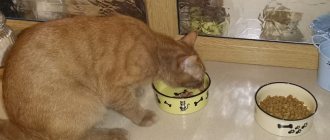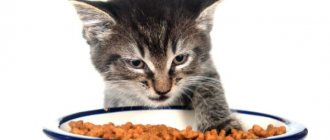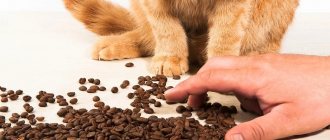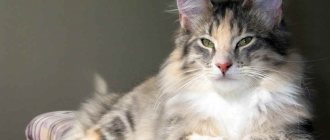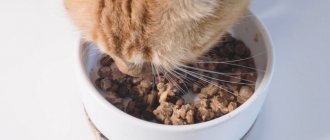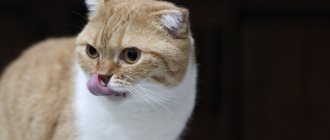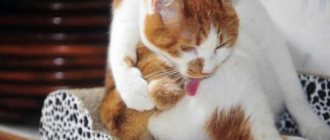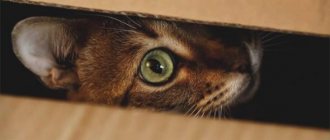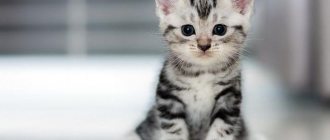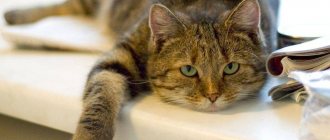When a person adopts not a kitten, but an adult pet, sometimes he is faced with the fact that the cat categorically does not eat dry food. Most often this happens because the cat got used to eating something else while living with the previous owner or on the street. Volunteers at the Murkosha shelter often encountered a similar problem and over time developed a specific strategy that helps transfer the cat to dry food.
1) The benefits of dry food 2) Why an adult cat does not eat dry food 3) Why a kitten does not eat dry food 4) Features of accustoming to dry food
The benefits of dry food
The very first and most important question: is it necessary to switch the cat to dry food at all? Need to! The fact is that the food on our table does not even closely resemble the diet of the wild ancestors of modern cats in their natural environment. In other words, such food will not be balanced for cats. Even more - certain products (very often found on our table) are extremely dangerous for a cat’s body.
Read more: Natural food for cats: benefit or harm?
Experienced volunteers, specialists from the Murkosha shelter and veterinarians almost unanimously say that you should prefer high-quality professional food. Its advantages:
— balance – the food contains a sufficient amount of fiber, vitamins and the correct ratio of proteins, carbohydrates, fats; - ease of determining the norm - the amount of food is determined by the age and weight of the cat; — no threat of poisoning if stored correctly; - a wide selection of feeds - there are therapeutic and preventive feeds intended for different breeds and ages.
Ignoring your regular diet
A cat that is fully accustomed to dry food may suddenly refuse the contents of its bowl. There can be several explanations for what is happening:
- Saturation . The usual taste and smell of food is not so tempting for the taste buds, and the animal goes on a hunger strike, waiting for a treat.
- Binge eating . Domestic cats lead a measured and calm life, staying in a sweet slumber for 18 hours a day, and therefore energy consumption does not exceed the calorie content of feeding. Wild relatives obtain food with great difficulty, expending a lot of effort and muscle energy. That is why the cats, who have never known hunger, begin to be capricious in their food, obeying the instinct that forces them to relieve the body.
- The bowl is never empty. The mustachioed tabby can treat food very coolly, knowing that nourishing and easily accessible food is always available in the designated place.
What to do?
If the pet’s general condition does not suffer, then there is no need to worry, and a short-term hunger strike will benefit the spoiled picky dog.
To correct the situation in the future, felinologists recommend:
- periodic changes in the tastes of dry food within the same brand;
- transfer to products of another manufacturer;
- portion feeding by the hour;
- reducing the daily norm if the animal does not eat the offered portion;
- removing leftover food;
- increasing your pet’s physical activity through games and entertainment.
Why doesn't an adult cat eat dry food?
There are several main reasons for refusing dry food:
1. Habit. If a cat lives with a person, it gets used to the latter’s lifestyle and diet. Such habits are difficult to eradicate because they begin to work at the level of reflexes.
2. Wrong smell. Often, cats don't like a certain type of food simply because it doesn't smell like natural food. If, for example, a cat is accustomed to catching mice or eating meat from the owner’s table, then after sniffing the food, she will understand that it is a completely different product and will begin to refuse.
3. Consistency and temperature. These two parameters are very important for a cat. And if he doesn’t like the food to be cold or too large, the cat will refuse to eat it.
The cat was given a try for the first time
It often happens that the cat’s owners have given fish, meat, cheese, poultry, and sour cream since childhood. But now we decided to buy dry food. And suddenly the animal refused. In this case, it is better to return to the previous diet so that the cat does not develop an upset stomach or intestinal problems.
Another situation is when the kitten does not eat dry food. What to do? There are two options here:
- Keep the same diet as it was (if he has already tried solid food).
- Buy other food (dry and wet).
In any case, you need to watch how the baby behaves. You can offer a variety of dishes, but do not overdo it, for example, sour cream, fish, poultry, dry food from different manufacturers.
Just do this not immediately, in very small pieces/portions, for example the size of a pea. Don't interrupt your kitten's appetite. For example, treat him with sour cream or a piece of cheese in the morning, and offer dry food or pate for lunch (of course, if he doesn’t eat anything offered). But if, for example, a cat recognizes sour cream as a good food, then it is better to give it about 1 tablespoon every morning.
Why doesn't my kitten eat dry food?
You should start accustoming a kitten to dry food after 3 months (it is possible at 1-1.5 months, but strictly if the kitten receives milk from its mother cat). Usually, if the kitten has not yet been accustomed to home-cooked food, the process goes quite quickly and the kitten easily begins to eat dry food. But some people are picky. And it also happens that a kitten, who has already begun to get used to dry food, suddenly refuses it. This often confuses owners. But most likely the reason lies in one of the following:
1. The kitten does not have enough clean drinking water. If a kitten eats dry food, then it should consume much more water than with other types of feeding (natural food, wet food). With a dry diet, the pet must have unlimited access to drink, since a large amount of moisture is spent on softening the granules.
Read about what water should be like for your pet: Can cats drink tap water?
2. You should not mix old and new portions of food, especially if the proportion of dry food is not yet 100% and all the food is in one bowl. The food left over from the previous meal acquires an unpleasant smell for the kitten (especially if the food tends to spoil quickly, and this includes, for example, wet food), so he refuses it. To prevent this from happening, you should:
- correctly calculate the serving volume; - wash the cat's bowl after feeding; — offer other “meals,” including cat treats, in separate dishes.
3. The problem may also be due to improper storage of feed. Factory packaging that does not have special fastenings is not very suitable for storage after opening, since the food can deteriorate and the aroma is lost. And food that does not smell is no longer food for a kitten. The solution here is a special container with a tight lid for storing food, which can be bought in any household goods department.
What should the owner do?
The response directly depends on the cause of poor appetite. After finding out, you will have to eliminate the factors that irritate your pet, choose another feeding option, or take time to accustom him to unfamiliar food.
Determining the cause of feed rejection
If you detect alarming symptoms indicating the presence of pathology, you should not put pressure on the animal, forcing it to eat against its desire. In this case, simply contact your veterinarian. After treatment, your appetite will return on its own.
If your cat doesn’t eat dry food well, not because of illness, consider the specific situation:
- Loss of smell. With proper care, a mild cold will quickly go away on its own. If the olfactory function has disappeared due to old age, then it makes sense to switch to natural products with more pronounced odors.
- Hot weather or heat. Both situations resolve on their own after some time. You just need to make sure that your pet drinks the daily amount of water during fasting days.
- Increased anxiety. Create a comfortable corner where the animal can be alone. Give him enough attention to avoid jealousy of the new inhabitants and distract him from other irritating factors.
- Mode failure. Dispense food at specific times, strictly following the recommended portions on the package. Avoid table handouts and remember to include wet canned foods and treats in your daily caloric intake.
- Dental problems. Elderly pets need to choose a more gentle diet that does not injure mucous membranes and loose teeth.
- Recent transition to natural drying or getting used to cheaper brands. Here you need to be patient and just stick to the basic rules. Sooner or later, your pet will come to terms with the new diet and wean itself off the old one.
- Spoiled pellets. Do not buy by weight and do not take large packages that will be stored for more than 1.5 months if opened. After opening the package, pour the contents into an airtight container with a lid and store in a cool, dark place.
- Lack of hygiene or incorrect material. Rinse bowls with boiling water regularly to remove unpleasant odors and kill bacteria. Remember that microcracks in plastic quickly harbor pathogenic microorganisms. It is much safer to purchase products made of metal or ceramics.
When getting accustomed to unusual foods, take into account the timing of fasting. A complete refusal to eat is harmless for 2-3 days in adult animals and for 24 hours in kittens. Don't starve your pet. If your relationship with dry food doesn’t work out, just try other options.
Choosing the right food
The taste of the product plays a significant role. Your pet may not like the taste of chicken or turkey. In this case, choose pellets with lamb, salmon, rabbit, duck or fish. These options will cost more, but they will definitely please your picky eater.
You can also diversify your diet with pieces of meat in spider jelly and soft canned food. Please note that in this case the amount of feed must be reduced.
If all these tricks don’t work, try changing the brand. As a last resort, you will have to switch to natural feeding, since some animals categorically refuse to eat industrial feed.
Accustoming a kitten to pellets
In childhood, the transition to dry food is easier, since the baby has not yet had time to adapt to other products and is familiar only with mother’s milk. “Crusks” can be given as the first complementary food, that is, at 1-1.5 months.
For a healthy diet, lines designed specifically for kittens are suitable. Due to their high calorie content and abundance of vitamins, such products quickly fill you up and promote proper development.
Follow the standards indicated on the packaging and be sure to soak the hard “crackers” in warm water or milk formula until your pet’s first teeth erupt. For the first time, apply the resulting mixture directly to the nose so that the baby will lick it off automatically. Over time, he will get used to the unusual taste and smell.
Having noticed a positive trend, begin to gradually reduce the amount of liquid used. As soon as your pet is confidently chewing dry granules, diversify the diet with wet canned food. Eating foods of varying textures will help prevent gum damage and tartar buildup.
The cat is tired of the taste or consistency
Cats, like people, get tired of the same food over time. If your pet eats the same food for a long time, he may simply get bored with it and want variety. If your four-legged pet suddenly begins to refuse his usual food, perhaps it’s not that it’s spoiled or the bowl smells of something, he just doesn’t like it anymore.
Refusal to feed is a kind of blackmail on the part of the tailed cunning creature. Thus, he tries to beg the owner for something more tasty. You should not force your four-legged picky eater to eat the food he usually eats. It is better to change the brand of food after coordinating your choice with your veterinarian. The transition from one finished product to another should be gradual. This process should take 1–1.5 weeks.
Loss of quality
We are not always with our pet. Everyday life requires us to constantly leave and leave. Then you have to give the cat food in reserve. But, as you know, after lying for some time, food loses its original smell and taste. Your pet may not like it. A similar situation arises when owners buy packages of food that are too large and the cat does not have time to eat everything. As a result, the product deteriorates and no longer meets its taste. Over a long period of time, it can change its smell or attract moisture.
In order for your cat to always eat with pleasure, his food should be in a clean and dry bowl. A cat is a fairly clean animal. The conclusion is that it is necessary to wash the bowl daily or at least every other day.
The choice of dishes also affects the cat's appetite. You should choose a container that is not deep, but spacious. It is desirable that it be heavy so that the pet cannot knock it over with its paw. Lack of clean water near the food can also cause him to refuse to eat. The thing is that cats simply need clean water. If there are foreign products in it, the animal may not like it. Lack of water, like in humans, will lead to digestive problems. The kitten refuses to eat dry food. What to do and how to correct errors? Maybe it's worth waiting if he hasn't grown yet?
An animal may not eat food when it is a kitten. His little body is not yet accustomed to such food, especially after his mother’s milk. It’s worth waiting until he grows up and starts eating it himself.
The next reason for an animal to refuse food is a sudden change in food. Let’s say a cat is fed food he has prepared himself, and then they want to switch him to food. Such a solution will most likely not yield results, since the animal is not accustomed to dry food.
There are also more serious reasons when a pet refuses not only dry food, but all food at once. In this case, the development of some disease is possible. A cat cannot tell us what hurts. If you have any suspicions, it is better to immediately take your pet to the veterinarian. Your beloved furry will certainly be helped there.
If your pet has no health problems, then teaching him to eat food is quite possible. All it takes is patience and time. In order to do this as quickly as possible and without unnecessary nerves, it is worth attracting the animal to a new food.
Problems with well-being
If your pet has lost interest in food, the first thing you need to do is rule out health problems. Older cats (and it happens to young cats) sometimes refuse dry food due to problems in the oral cavity. In this case, the animal still wants to eat, but is afraid of chewing the pellets because it causes pain. Examine his mouth for redness of the gums, ulcers on the mucous membrane, and loose teeth.
If something like this is discovered, you need to contact a veterinarian and follow his recommendations. During the treatment period, dry food will have to be soaked or temporarily replaced with wet food.
Sometimes cats don't eat well because they're in heat or in hot weather. In this case, you just need to wait a little, and interest in food will return by itself. The main thing is not to forget about clean, fresh water: it should be freely available around the clock.
When, in addition to refusal to eat, other alarming symptoms are observed: fever, lethargy, vomiting or diarrhea, you should not hesitate to seek veterinary help. You should also sound the alarm if your pet eats absolutely nothing for 2-3 days.
Physiological causes of decreased appetite in cats
Cats are characterized by instability of appetite, this is due to the fact that they are predators. In their natural habitat, cats do not have the opportunity to receive food in the same amount every day. Today she was lucky to catch three mice and one bird, and tomorrow only one mouse. For our pets, food is always available in the right quantity, but sometimes they can relieve their body for a day and eat a little less food than usual without harm to their health.
Another factor influencing appetite is the sexual activity of animals. Uncastrated representatives of the cat tribe, in search of love, sometimes completely forget about food, and doctors will not help here. If a pet is losing weight, and the owner does not consider it necessary to castrate it, then he must take care of the calorie content of the diet so that the animal receives the required amount of energy in small portions.
To understand that a cat has become poor at eating food precisely for a physiological reason, you need to carefully observe it throughout the day. If she continues to drink water, is active, sociable, has a clear look, and her natural functions remain normal, then there is no need to worry. If fasting continues for more than a day while feeling well, or you notice your cat is feeling unwell already on the first day, you should immediately show her to a veterinarian - the sooner treatment begins, the easier and more effective it will be.
Health problems
A kitten’s refusal to feed often happens for reasons related to the health and well-being of the animal. Here are the most common ones.
- Poisoning.
Cats are by nature very curious creatures, what can we say about little kittens who want to taste everything in sight? It is quite possible that some bad product will come across and cause poisoning in a small cat. In this case, the cat will refuse any product. You should not force-feed him; it is better to take him to a veterinary clinic and show him to a specialist. He will select treatment methods and prescribe rehabilitation therapy. - Disease of the gums or teeth.
A cat may well get stomatitis. Then the food granules will begin to cause pain to the animal, and it will begin to refuse this food. - Helminthiasis.
A kitten, especially if it likes to walk outside, can very easily pick up worms or some other parasites. The owner can visually determine their presence, but it is better to contact a specialist who will conduct an examination and prescribe treatment.
How to solve this problem
- With the help of a veterinarian.
If there is reason to believe that the kitten has health problems, then you need to go to a veterinarian for a detailed examination and prescription of treatment procedures. - Agree with all the kitten’s demands.
If the kitten is stubborn in his reluctance to eat dry food, then you can meet him halfway and feed the animal only those foods that he loves and prefers to eat. - The best option is to teach the kitten to eat dry food.
The previous point is impossible for those who work - the owner simply physically does not have time to prepare his favorite cat food. For such people, the best option is to accustom the pet to dry food while it is still small.
Why is it important to monitor your baby's appetite?
“Beginner” owners probably have a question: why and where does so much fuss and indignation come from when it comes to some kind of appetite? Is it really so important that it be regular, full and healthy? In fact, as was mentioned just above, appetite is almost a key indicator not only of health, but also of the baby’s overall condition. For example, as soon as he is literally torn away from his mother, he experiences strong emotional experiences and may lose his appetite, which will tell us that not everything is in order with the animal’s condition.
Important rules for transferring a pet to dry food from other types of food
When switching a cat to another type of food, you must follow several important rules:
- Taking into account the needs of the pet. The cat's preferences should be taken into account before offering another food. If your pet is a big fan of chicken, then it is unlikely that he will eat meat crackers. But indicating the type of meat on the package is not an advertising ploy, as many people think. A self-respecting manufacturer provides truthful information, which cannot be said about budget food. They use flavorings that are identical to natural ones. In addition, high-class industrial food is initially designed for the specific needs of the pet: to facilitate the removal of hairballs, for sterilized cats, for active cats. You should immediately take these nuances into account so that your pet receives a diet that suits its needs.
- Gradual means a gentle introduction of industrial feed into the diet. A sudden change is harmful and even destructive. It is enough to replace 1/10 of the usual portion with “crackers” and increase it daily by 1/10.
Every day you should replace only 1/10 of your pet’s usual diet with dry food.
- Time. The transfer from one type of feed to another should be carried out within 10–14 days. During this time, the cat will already taste new food. After this time, only the industrial product should be in the bowl.
- Unobstructed access to water. This is the most important rule when feeding commercial food.
The nuances of switching to dry food from different diets
Depending on what the cat ate previously, there are some nuances when switching it to dry food.
From wet industrial food
If the cat ate canned food, that is, wet industrial food, then everything is simple. In the first 2-3 days, crackers must be pre-soaked to the desired consistency. Gradually, soaking can be replaced with light moistening with the sauce from these canned foods. That is, mix the granules into a bowl, let it brew, and then offer it to the cat. At the last step, you can simply stir in either just the sauce or just the pieces. And after complete adaptation, leave only dry food.
From natural homemade food
The same rule applies here as with wet food. But cats are very suspicious animals and can easily recognize deception. Experts recommend starting with mixing canned food into natural food, and only then switching from wet industrial food to dry food. By the way, it will take the same amount of time: about two weeks.
There is another, simpler way: offer a dry food pellet as a treat. And specifically for a hungry pet. If no problems arise, then pour the food into the bowl during feeding hours.
My mother decided to switch her cat to dry food. I bought him a pack of Royal Canin. But the pet did not appreciate the taste or smell of the new food at all - he simply buried it with his paw, twitched his tail and walked away. Mom tried to soak it and mix it in, but the cat had no intention of even trying the new treat. Then they bought him a banal “Friskies”. It was he who ate him by both cheeks. But, of course, you can’t feed an animal with this product all the time. The next experiment was with Purina Van food. It fit perfectly too. And finally, the final product in this chain was Purina ProPlan food. Both the owner and the pet settled on it; it suits them in all respects. So if your cat refuses dry food, he may simply not like the taste or smell of this product. And never buy large packs of expensive food at once - there is a chance that you will have to feed it to street cats.
In case of partial replacement of other feeds with dry food
Many cats are not particularly mischievous and happily eat both wet and dry food. This is quite normal, especially if there is only one manufacturer. As a rule, problems with replacement do not arise here. The owner should only strictly decide at what hours he feeds dry food and at what hours he feeds wet food.
Economy and premium food
There are economy and premium food. From the names alone you can already understand that the first ones are cheap, and the second ones are more expensive or very expensive. Unfortunately, cheap options can be harmful to health, as they contain dyes, preservatives and not a gram of real, wholesome meat, and lack vitamins and minerals.
Premium food, as a rule, should contain not only dried meat, but also essential vitamins and minerals. There are special medicinal foods. Therefore, if there is no opportunity or desire to feed your pet natural food or the animal refuses, then it is better to purchase premium food.
How to train
How to properly accustom a kitten to a ready-made diet? Veterinarians advise following the main rule - introducing new food gradually:
- When the kitten is two months old, you can replace part of its daily diet with dry food, but be sure to soften it first - in water, in broth, in milk.
- You can mix such a “new product” with already familiar food. Over time, the kitten will not perceive it as something alien and suspicious.
- The amount of dry granules gradually increases, this period should take about a month.
- To diversify the diet, you can periodically give natural food, this will also improve the functioning of the digestive system.
- Already at five months, the kitten can only eat ready-made dry food. He must have access to clean and fresh water.
- There should be a day in the week when the pet will eat canned food or natural products.
Pathological (medical) causes of decreased appetite in cats
Just like people, cats want to eat less or not at all when they are sick. There are many medical reasons for deterioration of appetite, including general and local infectious diseases, pathologies of individual internal organs (gastrointestinal tract, urinary system and others), poisoning, foreign body stuck in the gastrointestinal tract, diseases of the teeth and gums. In fact, any ailment, from very minor to very severe, can affect the appetite of a cat.
Only a veterinarian can determine the exact cause, but the owner’s task is to help him with this. Therefore, observe the cat, note all alarming symptoms, and also analyze living conditions: the presence of vaccinations, chronic diseases; could the cat have eaten something harmful to it, does it have access to indoor plants, household chemicals. Check the cat's toys for damage, and if there is a child in the house, then check his small toys to see if anything is missing or damaged. Perhaps the pet's appetite and general condition have worsened due to the ingestion of a foreign body.
After analyzing the situation and assuming that the cat is starving for medical reasons, do not delay a visit to the veterinary clinic. Remember that after 48 hours of complete fasting, irreversible changes occur in the cat's liver: the healthy tissue of this organ begins to be replaced by fatty tissue, a condition called fatty degeneration (lipidosis) of the liver. An organ affected by lipidosis can no longer fully perform its function. The disease can be prevented by not letting your cat go hungry for too long. Therefore, you need to see a doctor as quickly as possible, establish a diagnosis, begin treatment and improve nutrition.
The reason is in the bowl (dirty, smelly, etc.)
Cats are extremely clean animals. Their sense of smell is much sharper than that of humans, so they are able to smell even a faint odor. A pet may stop eating its usual food because the owner rarely washes the bowl or it smells unpleasant for reasons not related to untimely washing. Liquid from the bowl of water may leak into the container containing the dry granules. That is why it is recommended to place them at a certain distance from each other to eliminate this problem.
When moisture gets into the food, it begins to become damp. If the animal does not completely eat the food at one time, microorganisms grow in it, as a result of which it begins to smell unpleasant.
What can you do to restore your four-legged pet’s interest in food? To do this you need:
- Wash the bowl and pour boiling water over it. Subsequently, do this every day.
- Place the container of water away from the food bowl, making sure that the contents of the first cannot get into the latter. Some cat owners prefer to use double bowls. This is not the best option. It is recommended to feed cats from separate bowls.
- Pour into the bowl exactly as many granules as your pet can eat at a time. If he has not finished eating, it is recommended to pour the food back into the storage container, discarding the top layer on which the animal’s saliva has fallen.
- When purchasing food bowls, give preference to glass or stainless steel ones. Plastic containers may smell unpleasant. In addition, plastic is porous and almost impossible to wash clean.
Features of feeding
There are several advantages to feeding dry food:
- It is easy to give the required portion, overfeeding occurs less often. Manufacturers provide a special table of the ratio of portions and weight, the age of the cat.
- Leaving the granules in the bowl for a while will prevent them from spoiling.
- Each manufacturer produces a large number of different types of food. They are intended for different breeds and different ages. There is food with medicinal properties for allergy sufferers.
- If one type of food is not suitable for the kitten, you can try another . The probability of finding the best option is high; a picky person who refuses such food will definitely like some of the food.
Different foods for lunch
If your cat is picky about dry food, prefers a certain flavor and manufacturer, and the bag or packaging with the one she doesn’t like is large, then you can try adding a little of it to her favorite food and mix.
But under no circumstances should you mix different types of food. Cats prefer separate meals. Adding pieces of meat to sour cream or milk will not lead to anything good. The same goes for dry food and canned meat. Such foods should always be given separately, but in such a way that the animal always has a separate bowl of clean water to drink.
